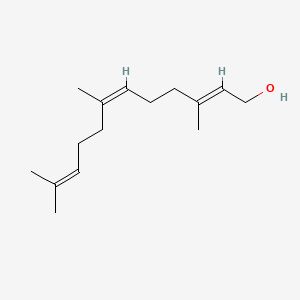| MeSH term | MeSH ID | Detail |
|---|---|---|
| Adenocarcinoma | D000230 | 166 associated lipids |
| Lupus Erythematosus, Systemic | D008180 | 43 associated lipids |
| Lung Neoplasms | D008175 | 171 associated lipids |
| Pancreatic Neoplasms | D010190 | 77 associated lipids |
| Colonic Neoplasms | D003110 | 161 associated lipids |
| Body Weight | D001835 | 333 associated lipids |
| Edema | D004487 | 152 associated lipids |
| Prostatic Neoplasms | D011471 | 126 associated lipids |
| Osteosarcoma | D012516 | 50 associated lipids |
| Glioma | D005910 | 112 associated lipids |
(e,z)-farnesol
(e,z)-farnesol is a lipid of Prenol Lipids (PR) class.
Cross Reference
There are no associated biomedical information in the current reference collection.
Current reference collection contains 3613 references associated with (e,z)-farnesol in LipidPedia. Due to lack of full text of references or no associated biomedical terms are recognized in our current text-mining method, we cannot extract any biomedical terms related to diseases, pathways, locations, functions, genes, lipids, and animal models from the associated reference collection.
Users can download the reference list at the bottom of this page and read the reference manually to find out biomedical information.
Here are additional resources we collected from PubChem and MeSH for (e,z)-farnesol
Possible diseases from mapped MeSH terms on references
We collected disease MeSH terms mapped to the references associated with (e,z)-farnesol
PubChem Biomolecular Interactions and Pathways
All references with (e,z)-farnesol
Download all related citations| Authors | Title | Published | Journal | PubMed Link |
|---|---|---|---|---|
| Winn LM and Wells PG | Evidence for Ras-dependent signal transduction in phenytoin teratogenicity. | 2002 | Toxicol. Appl. Pharmacol. | pmid:12460742 |
| Schnee C et al. | The maize gene terpene synthase 1 encodes a sesquiterpene synthase catalyzing the formation of (E)-beta-farnesene, (E)-nerolidol, and (E,E)-farnesol after herbivore damage. | 2002 | Plant Physiol. | pmid:12481088 |
| Koo H et al. | Effects of apigenin and tt-farnesol on glucosyltransferase activity, biofilm viability and caries development in rats. | 2002 | Oral Microbiol. Immunol. | pmid:12485324 |
| Hiyoshi H et al. | Squalene synthase inhibitors suppress triglyceride biosynthesis through the farnesol pathway in rat hepatocytes. | 2003 | J. Lipid Res. | pmid:12518031 |
| Halaschek-Wiener J et al. | Farnesyl thiosalicylic acid chemosensitizes human melanoma in vivo. | 2003 | J. Invest. Dermatol. | pmid:12535206 |
| Zoccarato F et al. | The adenosine inhibition of glutamate exocytosis in synaptosomes is removed by the collapse of the vesicle-cytosol deltapH plus the opening of farnesol-sensitive Ca(2+) channels. | 2003 | Cell Calcium | pmid:12618148 |
| Katzav A et al. | Inhibition of ras by farnesylthiosalicylate significantly reduces the levels of autoantibodies in two animal models of the antiphospholipid syndrome. | 2003 | Immunobiology | pmid:12638903 |
| Clarke HC et al. | Ras antagonist farnesylthiosalicylic acid (FTS) reduces glomerular cellular proliferation and macrophage number in rat thy-1 nephritis. | 2003 | J. Am. Soc. Nephrol. | pmid:12660318 |
| Jones TH et al. | Farnesylamine from the ant Monomorium fieldi Forel. | 2003 | J. Nat. Prod. | pmid:12662086 |
| Smalley KS and Eisen TG | Farnesyl transferase inhibitor SCH66336 is cytostatic, pro-apoptotic and enhances chemosensitivity to cisplatin in melanoma cells. | 2003 | Int. J. Cancer | pmid:12673674 |
